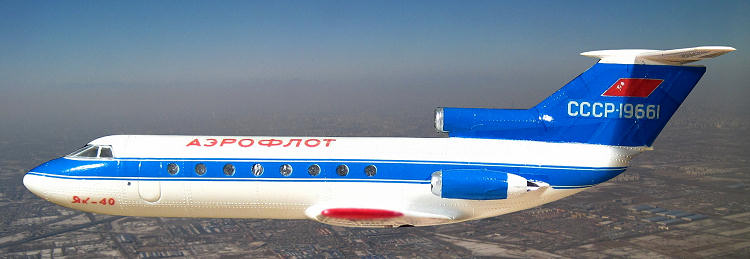
| KIT #: | ? |
| PRICE: | $? |
| DECALS: | One Option |
| REVIEWER: | Richard F |
| NOTES: |

| HISTORY |
If you ever find yourself in Nizhny Novgorod with a
desperate need to reach Khorog, you'll have reason to be grateful to Yakovlev
and Aeroflot. Their work in the 1960s on a small, reliable aircraft to replace
clapped-out old Antonov biplanes on feeder routes gave birth to one of the
world's first "regional jets", the compact Yak-40 tri-jet. You can sit back with
the other 35 passengers and marvel at how the little plane that entered service
40 years ago is still flying that route with Tajik Air via its Dushanbe hub.
That's 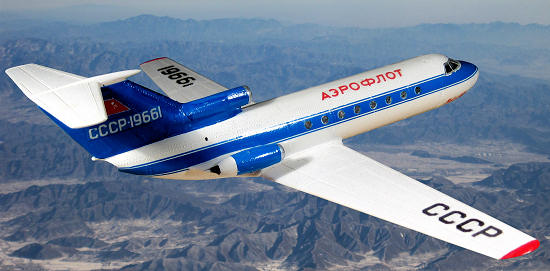 assuming
there are, in fact, 35 other people needing to get from Nizhny Novgorod to
Khorog the same day you do.
assuming
there are, in fact, 35 other people needing to get from Nizhny Novgorod to
Khorog the same day you do.
The Yak-40 is an extremely rugged and reliable aeroplane. It was designed to fly
reliably in poor weather and operate out of low-tech airfields (unpaved and
shorter than 700 meters). It has a built-in rear "air stair" to facilitate
boarding at basic airfields. It's a slow plane, reaching a top speed of only
550km/h (just under 300 knots). The popular Dash 8-100/200 turboprop, which
entered service over 15 years later, flies only slightly slower, from a 910
meter airstrip. Range for the two is roughly the same at about 1,800km. I saw
one once at Hamburg airport shortly after the end of the Cold War and it was an
attractive aircraft.
More than 1,000 of these airliners were built up to 1981. More than 400 of them
are still in service, mostly with airlines banned by the EU. Russia and its
former Central Asian republics are the best place to go if you want to ride on
one, though you can find them in Libya and Cuba too. Some Yak-40s have
been refurbished as business jets, available for charter in places like
Uzbekistan. It's hardly a G5 but they can be quite comfortable! Have a look for
yourself:
http://www.orexca.com/charter_flights.shtml
| THE KIT |
No-one could claim that the old East German model kit manufacturer VEB
Plasticart was in the same league as most western brands, even back in the day.
But one could - and I'm about to - claim that VEB made a few useful kits that
you can still enjoy today. They're basic, the instructions are hard to read, the
parts need lots of clean-up, they don't really fit and the decals are dodgy.
But let's face it, we are modellers and most of us do know how to sand, apply
putty, and get around these obstacles. For most of us, that's what makes it fun.
So, onwards!
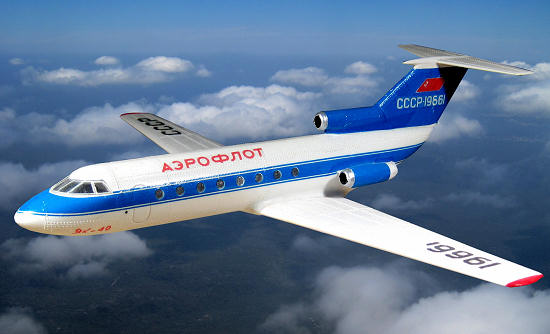
This little Yak has heavily raised rivet and panel line detail, nice turbojet
fans for the engines, and fairly primitive undercarriage. Moulded in a
relatively soft white plastic, the detail is overdone for the scale but the
plane is small enough that sanding it back, for those so inclined, wouldn't take
too long.
Clear parts are clear enough, and the kit comes with a sturdy display stand.
There's no interior, no proper wheel bays and only about 25 parts.
Finally, consider the alternatives for this and many other Soviet types. There
aren't that many readily available. MM's legendary vac-form master, Carmel
Attard, built a 1/72 vac-formed Yak-40 right here on MM:
| CONSTRUCTION |
The lazy man inside me really likes kits where there's
no cockpit. First, I don't have to build it. Second, I don't have to start my
review with "construction started in the cockpit". Instead, a splash of black
paint inside the fuselage and inserting the main cabin
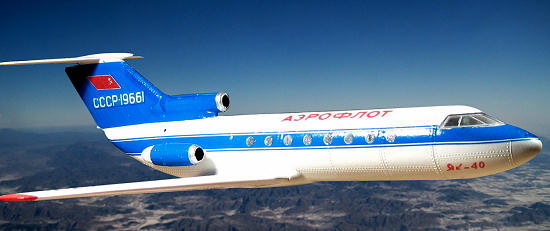 windows is all you need
to do before joining the fuselage. You don't even need to wait for the paint to
dry. Add nose weight if you want it to stand on its gear, but I didn't bother
because I wanted to use the display stand.
windows is all you need
to do before joining the fuselage. You don't even need to wait for the paint to
dry. Add nose weight if you want it to stand on its gear, but I didn't bother
because I wanted to use the display stand.
The kit fits together in the sense that the wings go into their slots and the
fuselage mates together reasonably well. You do need to use putty and sandpaper,
and prepare to spend a little time on that task. It's not a nightmare by any
stretch, but to get a decent join you will need to exercise some modeller's
skill.
The smaller components - the undercarriage - and also the trailing and leading
edges of the wings and tail, need some clean-up effort too.
The raised rivet and panel detail really is overdone, but I chose not to spend
the time in sanding it back. Obviously I lost some of this detail around the
seams but I did my best to minimise it.
| COLORS & MARKINGS |
The Yak-40 was (and is) used by a wide range of
airlines, many of them "exotic" to western modellers, such as Bakhtar Afghan
Airlines or Air Kokshetau of Kazakhstan. I don't know if after-market decals
are widely available, if at all, but the talented modeller
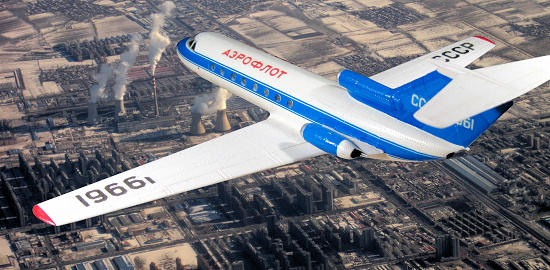 with the right
photographs could really make something special. In contrast, this kit gives you
the most bog-standard decal option, an aircraft flown by Aeroflot. In fact,
aircraft CCCP-19661 was the second of five prototypes (you can also tell this
from the number two engine inlet, which slopes back on series aircraft).
with the right
photographs could really make something special. In contrast, this kit gives you
the most bog-standard decal option, an aircraft flown by Aeroflot. In fact,
aircraft CCCP-19661 was the second of five prototypes (you can also tell this
from the number two engine inlet, which slopes back on series aircraft).
The instructions and box art called for the entire aircraft to be gloss white,
which I did with a Testors spray can. The rest of the colour scheme is done with
decals (though if I was building it again I'd do the blue with paint). Wing tips
are gloss red.
The decals went on surprisingly well for such an old kit and one from a company
like VEB. I lost a little of the wing-top serial number, and the blue around the
tail area needed trimming and collaging to get full coverage. You can notice in
some of the photos that parts of the tail decal seem to overlap.
| CONCLUSIONS |
Well, what to say? It's not a work of art. But it is pretty unusual and to my
eye it looks good in the way that vintage kits do. Huge rivets, very little
detail, but you don't build a kit like this to win contests. You do it for fun,
and to have something uncommon sitting on your shelf.
If you can find one, if you have a bit of patience, if you don't mind using your
modelling skills, and especially if you like unusual aircraft, then snap up this
Yak-40 and have an enjoyable weekend build.
| REFERENCES |
About the Yak-40:
http://en.wikipedia.org/wiki/Yakovlev_Yak-40
About VEB Plasticart:
http://en.wikipedia.org/wiki/VEB_Plasticart
February 2010
If you would like your product reviewed fairly and quickly, please contact me or see other details in the Note to Contributors.